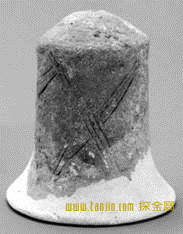Located on a hillside in the northeast of Nanlong Village, Pingyuan Town, Pingtan County, Fujian Province, and about 15 kilometers southeast of Pingtan County, it is an important Neolithic cultural site with an area of ​​more than 4,000 square meters. Pingtan is a county in eastern Fujian Province. It consists of Haitan Island, the largest island in Fujian, and 126 other small islands. The terrain is dominated by the marine plains, with low hills and flat terrain, facing Taiwan Island across the sea. It is also the nearest place to the mainland of China for Taiwan. Shell Hill site is located in the northwest of Haitan Island, about 5 meters above sea level. In 1964, the site was first discovered and two archaeological excavations were conducted in 1985 and 2004 respectively. Among them, in the 1985 archaeological excavations unearthed some special shape of ceramic feet. With regard to these pottery feet, academic circles have always been controversial. In recent years, many scholars believe that it is not the foot of pottery, but may be the "Too ancestor", that is, the reproductive cult of ancient ancestors. Pottery feet are less likely Archaeological discoveries have proven that in many ancient Chinese cultures, various utensils used as cooking utensils often have three feet, such as tripods, pipa, pipa, pipa and pipa. Among them, Ding and Yan are the most important, thus forming a distinctive and unique “Dingyi Cultureâ€. In fact, the emergence of Tao Ding is far earlier than it is and the scope of distribution is wider. Before the appearance of Tao Ding, there was a period when the use of pottery was used. So, what is the foot of the pottery? “The so-called foot is the three separate objects that are supported under kettles, pans, and other crockery during cooking. Its role is to create a space under the clams for burning.†Professor Yan Wenming, a professor at the College of Archeology and Literature. However, the initial support may use natural stones because in the early Neolithic Zhejiang Hemudu culture, some stones with similar foot shapes were found, and smoke marks on one side were evident. evidence of. Because stone processing was very difficult for the ancients, people slowly learned to use clay to make feet, so that the ceramic feet came into being. So far, the earliest potter's foot has been found in Hebei, which was about 8000 years ago in the early Neolithic Age. Magnetic mountain culture. Tao Zijiao has a wide distribution in China's Neolithic culture. The period of the emergence of the Tao Zi feet is sooner or later, and the duration of the period is short and long. Judging from the characteristics of the shape system, the feet of China's pottery can be roughly divided into seven types: inverted shoe shape, pig shape, head shape, angle shape, cylindrical shape, tower shape, and taro column shape. Relatively speaking, these pottery feet unearthed from the Qiqiutou site are mostly hemispherical at the top, and their bodies are cylindrical or conical in shape. Once they are supported by pots and pans, etc. Shake, causing the kettle pot center of gravity and dumping. And under the enamel device is too narrow, can not form enough space, not easy to fire, but also impossible to achieve the desired heat transfer effect, and no smoke or burn marks found on the surface. Therefore, in terms of qualitative function, it is not appropriate to name the pottery foot as its use function. May be a reproductive cult From the point of view of the method of creation, Chinese characters are initially pictographic and are derived from pictorial text. "Book of Rites Rural Special": "Everything is based on nature, people are almost ancestors." And "Book of Rites Tan Bow": "Emperor, and also." In fact, in the early days of Oracle, and There is no word "zu", and when it is required to express "zu", it is written as "and" (pronunciation is zÇ”). From the shape point of view, "and" is "progenitor", "progenitor" is "and". The Chinese characters from Oracle to Jinwen and cursive characters are all written in the shape of a male root, namely, "and", which fully reflects the characteristics of Chinese characters as hieroglyphs. In comparison, these pottery feet unearthed at the Qiqiutou site are mushroom-shaped or arc-shaped at the top, cylindrical or conical in shape, some of the devices are also scribed with lines and lines, and the bottom is attached with a horn. The shape of the arch is very similar to the "and" character recorded in the ancient Chinese Oracle or Jinwen. Therefore, from the perspective of ancient records, these artifacts are more likely to belong to Tao Zu. Tao Zu was a kind of culture rooted in the ancient roots of our country. Since the 20th century, Swedish archeologist An Shengsheng discovered for the first time in the Yangshao Village of Dianchi County, Henan Province, two Tao Zou in late Yangshao culture, and now in Yunnan, China. Provinces such as Xinjiang, Inner Mongolia, Shaanxi, Gansu, Ningxia, Henan, Shandong, Shanxi, Hubei, Hunan, Guangdong, Guangxi, and Taiwan have all discovered the prehistoric Tao Zu, Shi Zu or Mu Zu, and Chinese archaeologists will explore The unearthed "progenitor" is interpreted as a male genital model, which is unambiguous. Therefore, some scholars believe that these pots resemble male roots, they may be Tao Zu, that is, the ancient primitive ancestors of reproductive worship. Multiple comparisons confirm guesswork These pottery feet unearthed from the Shell Hill site are similar to those of many Tao dynasties unearthed in our country in terms of the shape of the artifacts or the ratio between the length of the instrument and the diameter of the cross section. In particular, mushroom-shaped pottery feet, the whole is to adopt a simple representation of the way of modeling. Therefore, these pottery feet or pottery ancestors unearthed at the site of the Shell Hill site are in line with the basic shape of the prehistoric Tao ancestors unearthed throughout China. Judging from the times, a few of the Tao ancestors found in prehistoric sites in various parts of China were found in the late Yangshao culture, some 5,000 years ago, and the vast majority are found in the late Longshan culture, Qijia culture, Qujialing period about 4,000 years ago. Cultural and other cultural sites of comparable age. According to the several dating results of the Shell Hill site, its age is approximately between 5500 and 6500, basically equivalent to the early stage of the late Yangshao culture. According to this, these artifacts unearthed at the site of the Shell Hill site belong to Tao Zu and should be said to be reasonable in terms of the times. In the middle and late Neolithic era, due to the primitive tools used by people at the time, the lack of scientific knowledge, and the low ability to resist nature, the unpredictable natural forces pose a serious threat to human survival. Natural phenomena and human beings' own phenomena of pregnancy, production, sickness, and death have no way of explaining and are very mysterious and fearful. Therefore, they have created a distorted and illusory concept that all things have spirits, and thus think that fertility itself also has the dominion of the gods and will have sexual organs. Considered to be the image of a fertility god, or simulate the shape of the genitals with stones, pottery, wood, jade, etc., as cult objects, and use it as a substitute for fertility gods, a symbol of supernatural power, to dedicate worship and worship to pray for fertile growth. Although these conceptual behaviors seem to be somewhat absurd today, their emergence and prevalence are by no means accidental, nor do they come from the lust of ancient humans. On the contrary, this phenomenon is precisely due to the actual human needs of the population at that time. And an urgent desire. ã€Exploring the gold network】professional field of the most professional platform, you do not have to laboriously disassemble the detector, do not look at the lengthy stack of instrument features, to explore the gold network you can intuitively know which product is good, where not good Or get useful knowledge and fun to explore life.
TEA PACKAGINGS
Tea, as a daily beverage, is loved by people all over the world.So the tea market is huge.If you are a tea manufacturer.What should you pay attention when choosing tea packaging?Tea packaging shall be protective from mositure,oxygen,shock and aroa.Gonfor package have more than 35years manufacture experience in tea packaging.We can supply packages suit to all kinds of tea.There are main of Stand Up Pouch,vacuum packaging,Flat Bottom Pouch,back sealed bag,roll film.Materials usual to PET/PE,BOPP/VMCPP,PET/VMPET/PE,BOPP/VMPET/PE,PET/AL/PE and PET/AL/PA/PE.These structure of the laminated films protects the tea in good quality during sales and transportation.
Tea Packaging,Tea Packing Boxes,Loose Tea Packaging,Tea Bag Packaging ZHEJIANG GONFOR SOFT-PACKAGE CO.,LTD , https://www.chinasoftpackage.com

